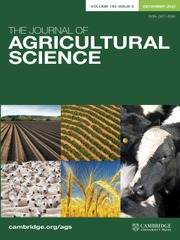Article contents
The influence of winter oilseed rape (Brassica napus ssp. oleifera var. biennis) cultivar and grass genotype on the competitive balance between crop and grass weeds
Published online by Cambridge University Press: 16 January 2007
Summary
Three experiments conducted over two years (2002–04) at the Crops Research Unit, University of Reading, investigated competition between autumn sown oilseed rape cultivars (Brassica napus L. ssp. oleifera var. biennis (DC.) Metzg.) and Lolium multiflorum Lam., L.×boucheanum Kunth and Alopecurus myosuroides Huds., sown as indicative grass weeds.
Rape cultivar (cv.) had a substantial effect on grass weed seed return. Over the six cultivars tested, L. multiflorum spikelet production ranged from just under 400 spikelets/m2 in the presence of cv. Winner to nearly 5800 in competition with cv. Lutin. Cultivar competitiveness was associated with high biomass, large dense floral layers and early stem extension. There was some evidence of differential competitive tolerance between rape cultivars.
The results suggested that rape cultivars could be screened for competitiveness by measuring floral layer interception of photosynthetic active radiation.
L.×boucheanum cultivars varied in ability to compete with rape. In the absence of inter-specific competition, spikelet density was similar for Aberecho and Polly (circa 31 000 spikelets/m2) but when grown with rape Polly outyielded Aberecho (i.e. 12 090 and 7990 spikelets/m2 respectively).
- Type
- Crops and Soils
- Information
- Copyright
- Copyright © Cambridge University Press 2007
References
REFERENCES
- 5
- Cited by




